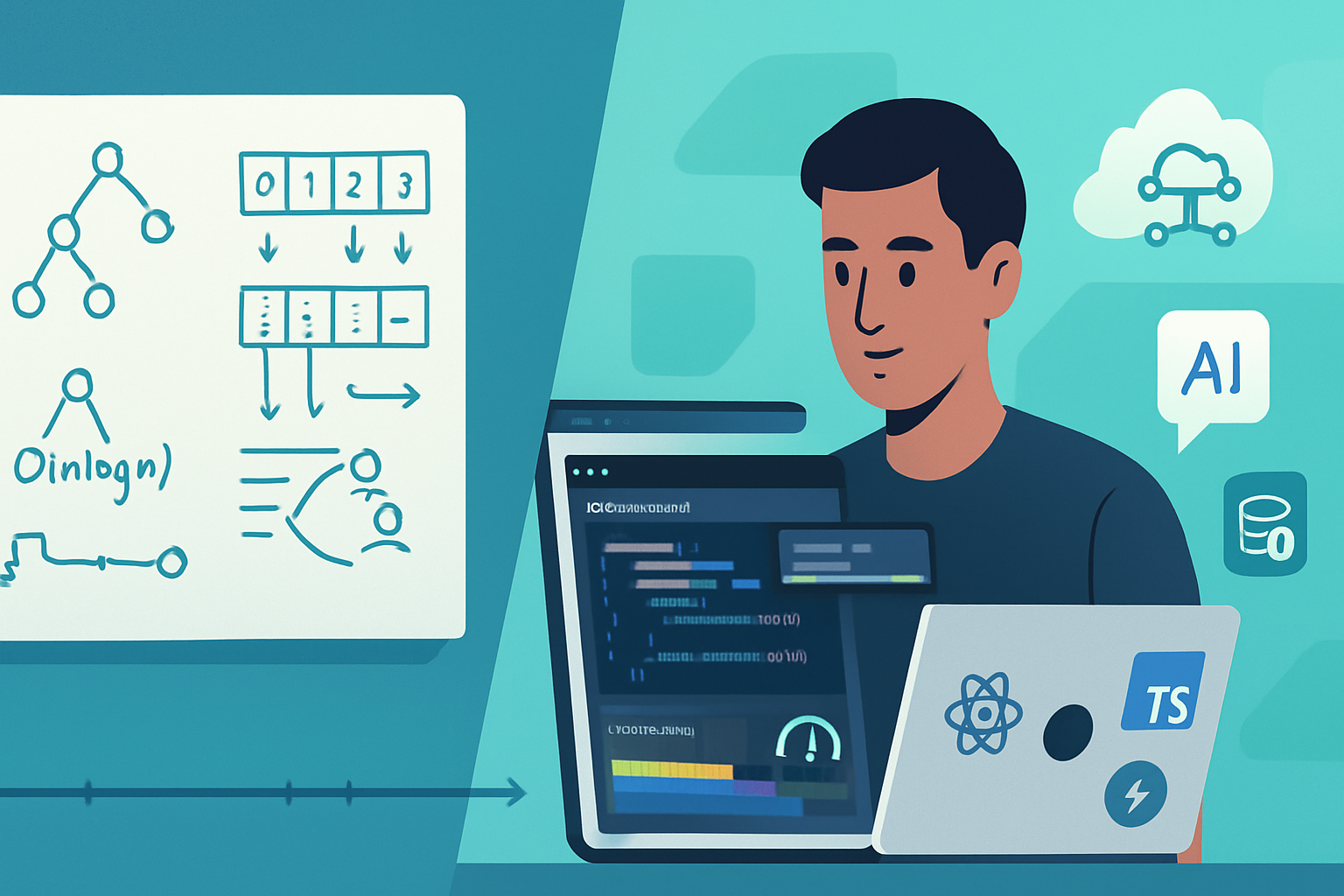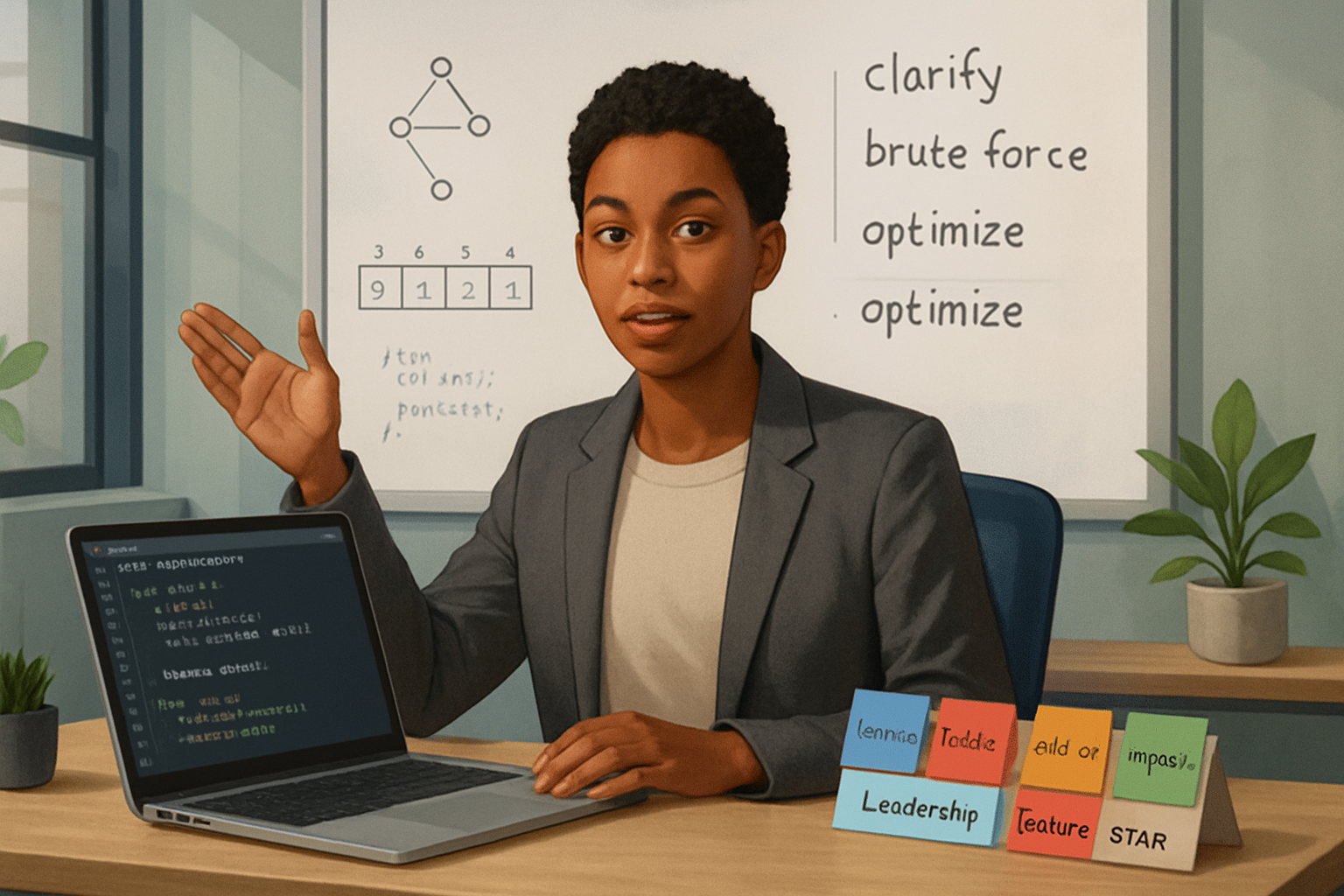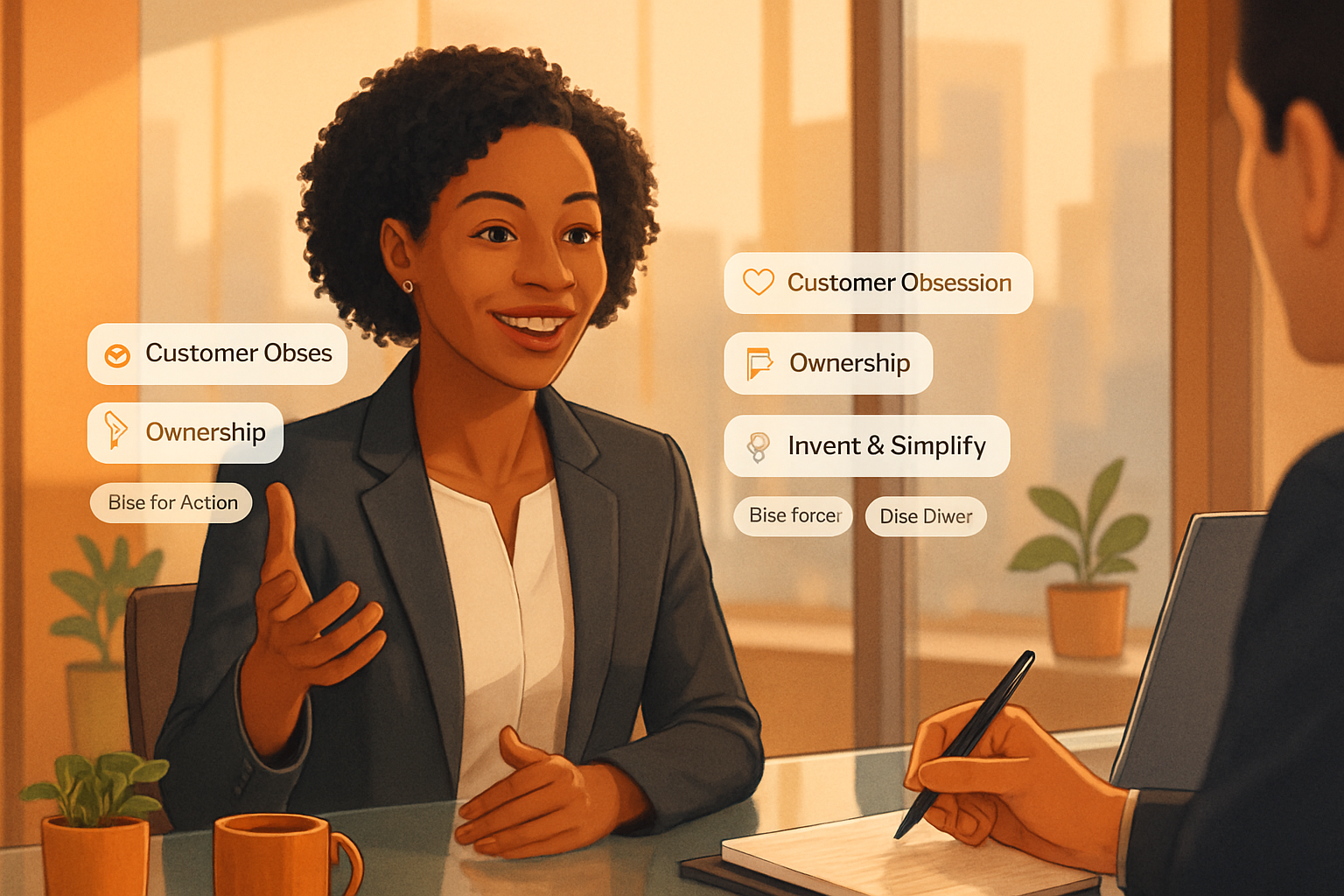· career · 7 min read
Navigating the Emotional Landscape: Answering Behavioral Questions in Frontend Interviews
Learn how to demonstrate emotional intelligence in frontend behavioral interviews with practical frameworks, real-world scenarios, and ready-to-use sample answers tailored for frontend developers.

Outcome-first introduction
You will leave this article able to answer behavioral interview questions for frontend roles with confidence and emotional clarity. Read on and you’ll learn how to surface emotional intelligence (EI) in your answers, structure responses to be concise and memorable, and practice examples that highlight collaboration, ownership, and growth.
Why emotional intelligence matters for frontend developers
Frontend work sits at the intersection of design, product and engineering. You write code, yes-but you also translate user needs, interpret design intent, and negotiate trade-offs. That requires emotional awareness, clear communication, and the ability to resolve conflict without breaking relationships. Interviewers ask behavioral questions precisely to find out whether you bring those human skills as reliably as you bring technical ones.
Behavioral interviews are not empathy tests. They are signals. Show that you can read context, manage emotions, and drive outcomes. That combination is rare and valuable.
How interviewers assess EI (quick primer)
- Self-awareness: can you describe how you felt and why?
- Self-regulation: can you manage feelings under pressure?
- Social awareness: can you see others’ perspectives?
- Relationship management: can you collaborate, influence, and de-escalate?
These dimensions are what hiring teams look for. For background reading, see the Emotional Intelligence overview and evidence that EI predicts workplace effectiveness: https://en.wikipedia.org/wiki/Emotional_intelligence and https://hbr.org/2015/11/how-to-manage-your-emotions-at-work.
A simple framework for behavioral answers: STAR + Emotional Layer
Interviewers already expect the STAR format (Situation, Task, Action, Result). Use it - and add an emotional layer. That means explicitly naming: how you felt, why you chose your approach, and what you learned about working with people.
Compact STAR + Emotional Layer template
- Situation: Brief context.
- Task: Your responsibility.
- Emotion(s): What you felt and empathy for others (one short sentence).
- Action: What you did (focus on collaboration and decisions).
- Result: Concrete outcome and metric if possible.
- Learning: One sentence on what you learned and how you’ll act next time.
Example:
Situation: Our team had to ship a major redesign in two weeks.
Task: I was responsible for implementing the top-level navigation.
Emotion(s): I felt pressure and noticed the designer looked anxious about missing UX details.
Action: I proposed a quick alignment session, built a focused prototype, and created a checklist of accessibility requirements we could validate in the sprint.
Result: We shipped on time; navigation usability tests showed a 15% improvement; no accessibility regressions in production.
Learning: I now insist on a 30-minute design-engineer alignment before any sprint that touches navigation.
Common frontend emotional scenarios (with tailored sample responses)
- Design disagreement with a designer
Context: A designer proposes a visual change that you think will harm performance and accessibility.
Key emotions: friction, concern for users, desire to maintain team rapport.
Sample answer (STAR + Emotional Layer):
- Situation: On a project the designer recommended heavy, animated hero components for all pages.
- Task: I was responsible for implementing them and ensuring performance targets.
- Emotion(s): I was excited by the design but concerned about page load for users on slow networks; I also respected the designer’s intent.
- Action: I asked for a short design review, demonstrated a quick prototype with network throttling, and proposed an animation fallback and lazy-loading strategy. I framed it as “how can we preserve the feel while maintaining performance?” rather than “this won’t work.”
- Result: We kept the animations on desktop but used lightweight alternatives on mobile; First Contentful Paint improved by 25% versus the initial spec.
- Learning: I learned to bring data and options, not just objections - that keeps the relationship collaborative while protecting users.
Why this works: You show empathy for the designer’s intent, own the user impact, and offer a practical compromise.
- Tight deadline and technical debt
Context: You’re asked to cut corners to meet a release date.
Key emotions: stress, responsibility, desire for quality.
Sample answer:
- Situation: A release date moved up unexpectedly and the backlog included overdue refactors.
- Task: Ship a critical feature without compromising stability.
- Emotion(s): I was worried about long-term maintenance and felt accountable to the team.
- Action: I proposed a phased approach: release a minimal, tested MVP while scheduling a short follow-up sprint to clean up technical debt. I clearly communicated risks and put fast automated checks in place.
- Result: The feature deployed without incidents; the follow-up sprint reduced a recurring bug by 60%.
- Learning: When you can’t do everything, transparent trade-offs and a remediation plan protect trust.
- Production bug that affects users
Context: A UI bug makes a core feature unusable in production.
Key emotions: urgency, ownership, empathy for impacted users.
Sample answer:
- Situation: A merge introduced a regression that broke checkout for some users.
- Task: Fix the issue and restore user trust.
- Emotion(s): I felt urgency and concern for customers; I also wanted to avoid finger-pointing.
- Action: I triaged with the team, reverted the offending change, wrote a reproducible test, and communicated a clear status update to product and support. I joined the post-mortem and proposed a gated release checklist.
- Result: Checkout was restored within an hour; the post-mortem prevented recurrence.
- Learning: Quick ownership plus transparent communication calms stakeholders and prevents repeated pain.
- Receiving critical feedback in a code review
Context: A senior engineer leaves direct, blunt review comments.
Key emotions: defensiveness, desire to learn, and respect for colleagues.
Sample answer:
- Situation: My pull request received several blunt comments about architecture decisions.
- Task: Address the feedback and keep iteration moving.
- Emotion(s): I initially felt defensive but recognized the value of the critique.
- Action: I thanked the reviewer, asked clarifying questions to understand the alternatives, applied the agreed changes, and wrote a short rationale in the PR for future reference.
- Result: The PR merged with improvements; subsequent reviews were shorter because the rationale reduced ambiguity.
- Learning: Asking for clarification turns criticism into collaboration.
- Remote collaboration and misunderstood tone
Context: A Slack message is misread and escalates tension.
Key emotions: irritation, uncertainty, desire to repair the relationship.
Sample answer:
- Situation: A terse message from a teammate felt accusatory during a remote sprint.
- Task: Keep the feature delivery on track and restore good communication.
- Emotion(s): I felt frustrated but didn’t want to escalate.
- Action: I asked for a quick video call to clarify intent, listened without interruption, paraphrased their concerns, and suggested a better async pattern for future updates.
- Result: We re-aligned on priorities and avoided delays; the teammate later thanked me for taking the call.
- Learning: A short synchronous conversation often prevents prolonged conflict.
- Advocating for accessibility when product pushes back
Context: Product leadership deprioritizes an accessibility improvement.
Key emotions: conviction, patience, and strategic persuasion.
Sample answer:
- Situation: The product team wanted to postpone accessible focus states to hit feature parity.
- Task: Advocate for accessibility without blocking the roadmap.
- Emotion(s): I felt strongly about equitable access and wanted to avoid an all-or-nothing fight.
- Action: I created a short accessibility impact brief showing affected user groups, estimated implementation effort (one engineer, two days), and proposed a compromise: ship the feature with an accessibility shim and schedule the full implementation in the next sprint.
- Result: The team adopted the shim and completed the full fix the following sprint; we avoided harming users in the interim.
- Learning: Solid data and a pragmatic plan convert conviction into wins.
How to word emotional content without sounding unprofessional
- Use concise emotion statements: “I was concerned about…”, “I felt responsible for…”, “I could see why they were frustrated.”
- Avoid wallowing or oversharing. One sentence about feelings is enough.
- Always couple emotion with action and learning.
What to avoid
- Blame and speculation (don’t say “they didn’t care”).
- Rehearsed emotions that sound fake. Genuine beats melodramatic.
- Vagueness - give concrete outcomes and numbers where possible.
Interview-friendly language snippets you can practice
- “I noticed X and was concerned because Y, so I…”
- “I asked clarifying questions to understand their perspective and then…”
- “We decided on a compromise: X now, Y later. That reduced risk and preserved momentum.”
- “Afterwards I reflected and adjusted our process by…”
Questions to ask the interviewer that show EI
- “How does this team handle design-engineer disagreements?”
- “What communication patterns helped teams here move faster without burning out?”
- “How does the team measure and prioritize accessibility or quality work?”
These questions signal you’re thinking beyond code to team dynamics and user impact.
Practice plan (30 days)
- Week 1: Pick 6 scenarios from your experience. Write STAR + Emotional Layer answers for each.
- Week 2: Record yourself answering two scenarios per day; listen back and edit for clarity.
- Week 3: Pair with a friend or mentor and practice follow-up questions.
- Week 4: Do mock interviews, refine metrics in your answers, and prepare two questions per scenario to show reflection.
Resources
- STAR method overview: https://www.indeed.com/career-advice/interviewing/how-to-use-star-interview-method
- Emotional intelligence at work: https://hbr.org/2015/11/how-to-manage-your-emotions-at-work
- Emotional intelligence general overview: https://en.wikipedia.org/wiki/Emotional_intelligence
Final note - one key mindset shift
Interviewers want to hire developers who can build great user experiences and sustain healthy collaboration. Technical chops open the door. Emotional intelligence closes the deal. Show you can feel, act, and learn - all in service of users and teammates - and you’ll stand out.



